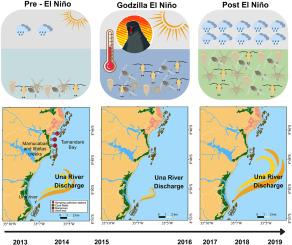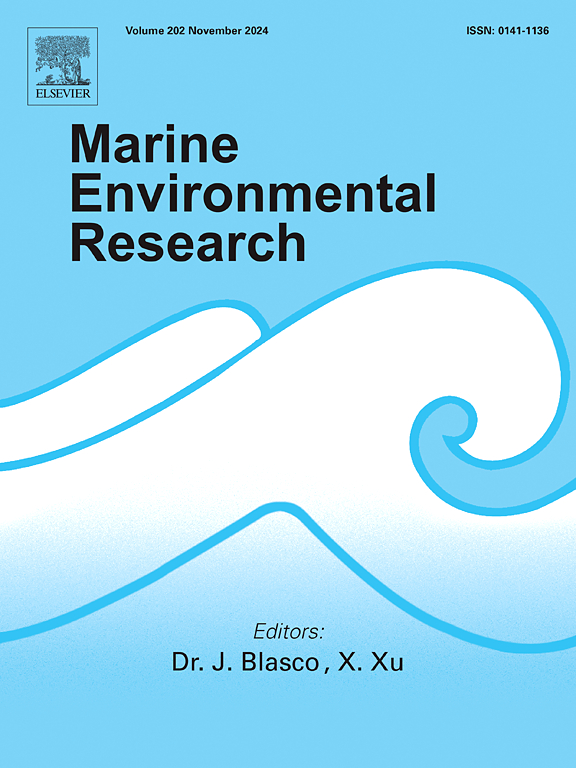Influence of the strong 2015/16 El Niño and extreme rainfall events on micro- and mesozooplankton in a coastal pelagic ecosystem of the western tropical Atlantic
IF 3.2
3区 环境科学与生态学
Q2 ENVIRONMENTAL SCIENCES
引用次数: 0
Abstract
In this study, we analyzed the effects of the record-strength 2015/16 “Godzilla” El Niño (EN), and subsequent extreme rainfall events (in 2017 and 2019) on local zooplankton communities in Tamandaré Bay, Brazil. Micro- and mesozooplankton (>64 μm) samples and abiotic data were obtained in, approximately, four campaigns per year, from June 2013 to August 2019. Micro- and mesozooplankton abundance, composition, and environmental conditions (chlorophyll a, salinity, temperature, winds, river discharge, and water transparency), and the Tropical Southern Atlantic SST index (TSA) were analyzed in a seven-year time series study. Local rainfall in the rainy seasons of 2015 and 2016 was far below the seasonal average, leading to lower Una River discharge and more transparent water in Tamandaré Bay during the EN period. Conversely, there were extreme rainfall events in 2017 and 2019, which had conspicuous effects on several abiotic factors. The copepod Euterpina acutifrons, the ciliate Favella ehrenbergii and “other ciliates” displayed high abundances in the rainy season. The 2015/16 EN led to a community change in the study area. We observed high abundances during the Post-EN period for many zooplankton taxa. The abundance of ciliate F. ehrenbergii was high in the Post-EN period and showed strong positive correlations with Una River discharge and chlorophyll a, showing that this species was strongly affected by nutrient inputs due to the peak in Una River discharge. This approach permitted new insights into processes and drivers that shape the pelagic ecosystem in a tropical coastal pelagic ecosystem.

2015/16年强厄尔尼诺Niño和极端降雨事件对热带大西洋西部沿海远洋生态系统微型和中浮游动物的影响
在这项研究中,我们分析了2015/16年创纪录强度的“哥斯拉”El Niño (EN)以及随后的极端降雨事件(2017年和2019年)对巴西tamandar湾当地浮游动物群落的影响。从2013年6月至2019年8月,每年大约有四次活动获得微型和中型浮游动物(>64 μm)样本和非生物数据。通过7年的时间序列研究,分析了热带南大西洋海温指数(TSA)和微浮游动物和中浮游动物的丰度、组成、环境条件(叶绿素a、盐度、温度、风、河流流量和水透明度)。2015年和2016年雨季的当地降雨量远低于季节平均水平,导致在EN期间乌纳河流量下降,tamandar湾的水更透明。相反,2017年和2019年发生了极端降雨事件,对多个非生物因素的影响显著。桡足动物Euterpina acutfrons,纤毛虫Favella ehrenbergii和“其他纤毛虫”在雨季表现出较高的丰度。2015/16年的EN导致了研究区域的社区变化。我们观察到许多浮游动物类群在en后时期具有较高的丰度。后en期叶氏纤毛虫丰度较高,且丰度与乌纳河流量和叶绿素a呈较强的正相关,表明乌纳河流量达到峰值时,该物种受养分输入的影响较大。这种方法使人们对热带沿海远洋生态系统中形成远洋生态系统的过程和驱动因素有了新的认识。
本文章由计算机程序翻译,如有差异,请以英文原文为准。
求助全文
约1分钟内获得全文
求助全文
来源期刊

Marine environmental research
环境科学-毒理学
CiteScore
5.90
自引率
3.00%
发文量
217
审稿时长
46 days
期刊介绍:
Marine Environmental Research publishes original research papers on chemical, physical, and biological interactions in the oceans and coastal waters. The journal serves as a forum for new information on biology, chemistry, and toxicology and syntheses that advance understanding of marine environmental processes.
Submission of multidisciplinary studies is encouraged. Studies that utilize experimental approaches to clarify the roles of anthropogenic and natural causes of changes in marine ecosystems are especially welcome, as are those studies that represent new developments of a theoretical or conceptual aspect of marine science. All papers published in this journal are reviewed by qualified peers prior to acceptance and publication. Examples of topics considered to be appropriate for the journal include, but are not limited to, the following:
– The extent, persistence, and consequences of change and the recovery from such change in natural marine systems
– The biochemical, physiological, and ecological consequences of contaminants to marine organisms and ecosystems
– The biogeochemistry of naturally occurring and anthropogenic substances
– Models that describe and predict the above processes
– Monitoring studies, to the extent that their results provide new information on functional processes
– Methodological papers describing improved quantitative techniques for the marine sciences.
 求助内容:
求助内容: 应助结果提醒方式:
应助结果提醒方式:


